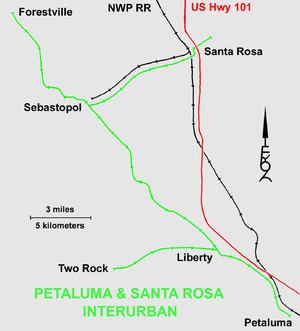22.6 mi36.4 km Stop 45 Founded 1903 | Status dismantled | |
 | ||
Riding in petaluma and santa rosa railroad 63
Petaluma and Santa Rosa Railroad was a 600 volt DC electric interurban railway in Sonoma County, California, United States. It operated between the cities of Petaluma, Sebastopol, Forestville, and Santa Rosa. A company-owned steamboat provided service between Petaluma and San Francisco.
Contents
- Riding in petaluma and santa rosa railroad 63
- Timeline
- Route
- The Battle of Sebastopol Road
- Roster of freight motors
- References
The Portions of the original right-of-way have been acquired by the County for the West County Trail, a facility managed by the Sonoma County Regional Parks Department. A portion of the original right-of-way can be found along the waterfront in Petaluma. There are plans to re-activate this line to become a trolley line once again.
Timeline
Route
From south to north:
The Battle of Sebastopol Road
The Petaluma and Santa Rosa line followed Sebastopol Road approaching Santa Rosa from Sebastopol. The construction crew needed to cross the north-south steam railroad to reach downtown Santa Rosa. The steam railroad had operated a parallel branch line from Santa Rosa to Sebastopol since 1890, and would not consent to the crossing allowing a new competitor to offer direct service downtown. Trolley service began to the west side of the crossing on 29 November 1904. Rails were laid on the east side of the steam railroad tracks, and an electric wire was strung overhead in preparation for installing the crossing. A crossing was prefabricated in Sebastopol and loaded on a flat car pushed to the crossing location. But when the interurban crew arrived to install the crossing on 3 January 1905, they found a pair of steam locomotives on either side of the crossing fitted with steam nozzles to spray hot water on anyone approaching the crossing site. The interurban construction crew retreated.
The following day the regularly scheduled interurban car #57 arrived secretly carrying the construction crew. Before the steam railway could respond, the crew laid a temporary track across and over the steam rails and had a team of horses pull trolley #57 across to serve downtown Santa Rosa. The steam railroad then obtained a temporary injunction from a San Francisco judge prohibiting installation of the crossing. For a few weeks, passengers from Sebastopol were required to depart their arriving trolley and walk over the steam railroad to reboard trolley #57 for the remainder of the trip.
The injunction was dissolved in late February and the interurban construction crew assembled again to install the crossing on 1 March 1905. The steam railroad appeared to be unaware of the status of their injunction, so their locomotives again discouraged the construction crew with hot water. The steam railroad also had a flat car loaded with gravel on hand for their men to fill in the excavation as soon as the interurban crew tried to dig out the crossing site. Tempers flared and several hundred Santa Rosa citizens assembled to watch the entertainment. Santa Rosa police ultimately restored order, and the crossing was installed that evening.
Roster of freight motors
The company roster included 89 conventional freight cars (unpowered trailers) in 1931.
